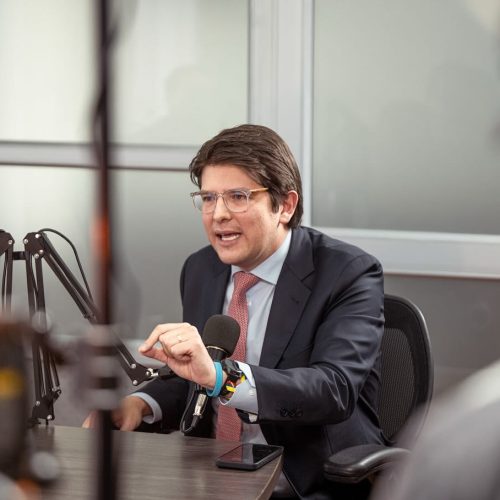Reflexiones de fe en la era digital
La doctora Daniella Zsupan-Jerome lleva aproximadamente 15 años trabajando en formación ministerial, enseñando a seminaristas, candidatos al diaconado y laicos que buscan ejercer el ministerio. Habló en exclusiva con MOMENTOS a propósito del lanzamiento de su libro Speak Lord, Your Servant is Listening.
POR MELISSA TOVAR GUERRERO
FOTOS CHRISTIN ROSKOS, LITURGICAL PRESS.

Dr. Daniella Zsupan-Jerome’s.
El área de especialización de la doctora Daniella Zsupan-Jerome es la teología pastoral y es experta en la teología y las prácticas de la comunicación pastoral, especialmente con relación a la cultura digital. También es oblata benedictina, una laica comprometida con los valores y las prácticas de la espiritualidad benedictina en su vida diaria y quien aprecia profundamente esta tradición y cómo invitar a descubrir algo sagrado en la forma de comunicarnos hoy.
¿Cuál fue el punto de partida que la llevó a escribir Speak Lord, Your Servant is Listening?
Llevo más de una década trabajando en educación teológica de posgrado. He tenido muchos estudiantes, preparándose para el ministerio, interesados en cómo abordar la cultura digital. Sus preguntas solían ser bastante prácticas e instrumentales: ¿cuáles son las mejores aplicaciones, plataformas, podcasts, cuentas y canales para seguir? ¿Cómo captamos el interés de los jóvenes? ¿Qué podemos hacer con la IA? Analizar estas preguntas nos da la pauta para abrirnos a una realidad más profunda: ¿qué significa relacionarse auténticamente con otras personas en los espacios digitales? ¿Qué significa estar presente? ¿Cómo escuchamos bien? Para mí, estas preguntas más profundas tienen sus raíces en la espiritualidad: en cómo establecemos una relación fundamental con Dios y cómo permitimos que esa relación moldee nuestra interacción con el mundo que nos rodea. Por esta razón, creo que cualquier enfoque prudente y fiel a los medios digitales comienza en el espíritu.
Las reflexiones que comparto en Speak Lord, por lo tanto, provienen de un contexto de formación. Comencé a usarlas hace unos 7 años como breves momentos contemplativos para abrir cada clase cuando trabajaba con estudiantes de ministerio. Continúo utilizándolos hoy de la misma manera, orando con los estudiantes al comienzo de la clase.
¿A quiénes está dirigido su nuevo libro?
Aunque creé las reflexiones de Speak Lord en el aula para estudiantes de ministerio, el público objetivo es más amplio. Cualquiera que busque abordar la cultura digital con reflexión y fidelidad se beneficiará de la pausa intencional y el espacio de reflexión que estas brindan. Una de las características de nuestra cultura digital es su comunicación acelerada, que a menudo invita a reacciones fuertes, rápidas e impulsivas para mantener la interacción. Este libro propone un enfoque diferente, más pausado, que brinda mayor autonomía al lector para que conserve la capacidad de detenerse, escuchar y reflexionar profundamente. Cualquiera que desee un ritmo diferente en su vida digital también apreciará este libro.
¿Qué variaciones y particularidades ha traído la era digital para que usted reflexione en su nuevo libro acerca de la “comunicación asertiva”?
Al reflexionar sobre el contexto digital, pienso principalmente en los aspectos relacionales de la comunicación digital, en la forma en que estamos presentes e interactuamos con otras personas en los espacios digitales. En el mejor de los casos, nuestra comunicación debe ser un regalo que hacemos a los demás, de forma amorosa y positiva. Me preocupa que en los espacios digitales a menudo evitemos esta disposición debido a la velocidad del medio y a que nuestra experiencia con los demás se reduce a “objetos” en la pantalla a los que reaccionamos: fragmentos de audio, imágenes, texto. Cuando olvidamos a la otra persona tras la pantalla, nos desarraigamos del núcleo relacional fundamental de la comunicación auténtica. El ritmo de la cultura digital desafía nuestra capacidad de acción y nos impulsa a actuar de forma impulsiva en lugar de reflexiva.
En el libro desarrolla la metodología “statio, escucha, reflexión, meditación y, oración”, ¿cuál es la importancia de cada uno de estos pasos? Deben mantener este orden o sus lectores pueden variarlos?
Este método es una adaptación libre de la lectio divina, una práctica contemplativa de larga data arraigada en la tradición monástica. En la lectio divina, o “lectura sagrada”, los monjes contemplativos buscan encontrar y conectar con la Palabra de Dios mediante un acercamiento pausado y cuidadoso a los textos sagrados. Es un ejercicio de desaceleración, escucha y reconocimiento de cómo la Palabra de Dios está presente en un texto sagrado y cómo nos invita a una relación más profunda. La esencia de la lectio divina es la escucha y la hospitalidad hacia la Palabra de Dios. La lectio también puede involucrar diferentes medios: arte sacro, cine, música e incluso la lectura sagrada de la experiencia diaria. Si bien los medios pueden variar, en mi opinión, el orden general de la lectio divina es importante. Es difícil encontrar la Palabra si nuestra vida interior es ruidosa, agitada y desordenada. Reducir la velocidad y escuchar nos prepara primero para descubrir la presencia de Dios. Los pasos posteriores nos invitan suavemente a interiorizar el encuentro, finalmente hacia un sentido contemplativo de comunión, una profunda e íntima cercanía con Dios. Es como nadar de aguas poco profundas a aguas profundas: el proceso tiene una lógica que nos permite abrirnos cada vez más a estos momentos.
Speak Lord, Your Servant is Listening es un libro teórico-práctico en el que le brinda las herramientas conceptuales a sus lectores y le propone ejemplos en cada capítulo para aplicar su metodología en diferentes escenarios. ¿Cuáles son los ejemplos que considera que pueden sorprender más a sus lectores por el alto nivel de aplicación de su propuesta teórica?
Este libro pretende ser, sobre todo, un devocional, un recurso para la vida de oración. La breve introducción teórica describe mi enfoque, pero la mayor parte del libro ofrece breves oportunidades para la reflexión en oración, quizás acompañadas de un diario o de compartir la fe en grupo. Dado que se centra en la comunicación fiel, el libro redescubre veinte escenas familiares de la Biblia e invita al lector a reflexionar sobre lo que estas nos enseñan en la comunicación misma. Por lo tanto, cada capítulo contiene un pasaje bíblico, una reflexión y algunas preguntas sugeridas para la oración personal o grupal. Cada capítulo concluye con una oración.
También se refiere a los influenciadores, un término que se ha generalizado y su significado se ha diluido. En términos del pastorado ministerial católico y del alcance secular de los creyentes, ¿qué significa ser influenciadores en la era digital?
Esta es una pregunta muy buena y compleja. Por un lado, los influenciadores digitales son los narradores y creadores de cultura de nuestro tiempo; guían la narrativa general de nuestra cultura y expresan nuestros intereses, valores y tendencias. Debido a su impacto, especialmente como narradores y creadores de cultura, son una realidad importante para la fe y el ministerio. El lenguaje y la práctica de la influencia han permeado a la Iglesia, desde los sacerdotes de las redes sociales hasta el difunto Santo Padre Francisco, quien se refirió afectuosamente a María como la “influenciadora original”, en una publicación en la red social X.
Al mismo tiempo, una estrecha relación entre influenciadores digitales y ministros resulta algo problemática. Los influenciadores digitales prosperan en el modelo de negocio particular de la cultura digital, buscando monetizar la interacción que obtienen de sus seguidores. Buscar la interacción puede, en ocasiones, comprometer su contenido y desplazar la interacción de su contexto adecuado como una auténtica conexión humana con un bien, algo de lo que se beneficia el influenciador. Si, como creyentes, tomamos en serio el impacto de los influenciadores digitales, podríamos reflexionar sobre su impacto como narradores y creadores de cultura, y su capacidad para convocar y conectar con sus seguidores. Al mismo tiempo, nuestras conexiones con los demás nunca deben ser un medio para un fin.
Usted lanzó su libro en medio de un momento crucial en la transición e incursión masiva de la IA, ¿puede desarrollarse una comunicación católica y de fe en medio de la rapidez de la IA y su influencia en la cotidianidad de las personas?
Este es, sin duda, un tema muy importante que debemos seguir analizando. Agradezco el documento del Vaticano de enero de 2025, Antiqua et Nova, que ofrece un marco filosófico útil sobre el tema, distinguiendo entre la función de la IA, y el intelecto y el pensamiento humanos. En muchos sentidos, la IA sigue ofreciendo eficiencias, como la velocidad de recopilación y agregación de datos. Al mismo tiempo, el pensamiento y la creatividad humanos tienen un carácter sagrado: son un reflejo de nuestro Creador y un recordatorio de que estamos hechos a su imagen. Atribuir pensamiento y creatividad a la IA, al margen de la persona humana, implica plantear afirmaciones teológicas radicales. Si bien las eficiencias de la IA son maravillosas, el encuentro entre personas tiene un valor irremplazable.
“Soy cauta respecto a la personificación de la IA, y especialmente ante la posibilidad de que se incorpore en contextos donde las relaciones entre personas deberían ser innegociables, como en la atención pastoral, la atención a la salud mental, la atención espiritual, el trabajo de duelo y otros ámbitos similares. La educación y la formación en la fe también figuran en esta lista”.
Reflections on Faith in the Digital Age
Daniella Zsupan-Jerome, Ph.D., has been working in ministerial formation for approximately 15 years, teaching seminarians, diaconate candidates, and lay people seeking to exercise ministry. She talked exclusively with MOMENTOS on the launch of her book Speak Lord, Your Servant is Listening.
BY MELISSA TOVAR GUERRERO
PHOTOS CHRISTIN ROSKOS, LITURGICAL PRESS.
Dr. Daniella Zsupan-Jerome’s area of expertise is pastoral theology, and she is an expert in the theology and practices of pastoral communication, especially in relation to digital culture. She is also a Benedictine Oblate, a lay person committed to the values and practices of Benedictine spirituality in her daily life and who deeply appreciates this tradition and how it invites us to discover something sacred in the way we communicate today.
What was your starting point for writing Speak Lord, Your Servant is Listening?
I have been working in graduate theological education for over a decade. I have had many students, preparing for ministry, interested in how to approach digital culture. Their questions tended to be quite practical and instrumental: what are the best apps, platforms, podcasts, accounts or channels to follow? How do we capture the interest of young people? What can we do with AI? When we begin looking at these questions, they tend to open us up to a deeper reality: what does it mean to relate authentically with other people in digital spaces? What does it mean to be present? How do we listen well? For me these deeper questions are rooted in spirituality: in the way we have a fundamental relationship with God and how we allow that relationship to shape how we interact with the world around us. For this reason, I think any prudent and faithful approach to digital media begins in the spirit.
The reflections I share in Speak Lord therefore come from a formation context. I began these about 7 years ago as brief contemplative moments to open each class when working with ministry students. I continue to use them today in the same way, praying with students in the beginning of class.
Who is your new book aimed at?
Although I created the reflections of Speak Lord in the classroom for ministry students, the audience is more broad. Any of us who are seeking to approach digital culture thoughtfully and faithfully will benefit from the intentional pause and space of reflection that these extend. One of the hallmarks of our digital culture is that it is fast-paced communication, often inviting strong, fast, and impulsive reactions to sustain engagement. This book proposes a different, slower approach, one with greater agency to the reader to retain the ability to pause, reflect, listen, and think deeply in our times. The reflections invite and hone this kind of mindset. Anyone who would welcome a different pace to their digital lives will also appreciate this book.
What variations and particularities has the digital age brought for you to reflect on in your new book about “faithful communication”?
When reflecting on the digital context, I think mostly about the relational aspects of digital communication, the way that we are present and interacting with other people in digital spaces. At its best our communication is meant to be a gift of oneself we make to others, done in a loving, positive way. I am concerned that in digital spaces we often eschew this disposition because the pace of the medium is fast, and because our experience of other people be reduced to “things” on the screen that we react to: soundbites, images, text. When we forget the other person behind the screen, we are uprooted from the fundamental, relational core of what authentic communication is. This challenge of reifying the presence of others into things on the screen, is often coupled with the fast pace of digital communication. We need opportunities to slow down, listen more carefully, engage more intentionally and thoughtfully in these spaces. The pace of digital culture challenges our human agency and pushes us to impulsive rather than thoughtful action.
What was the most challenging moment in your creative process and the writing of this book?
To create devotional work like this, one needs time and space for reflection, to practice the method of the book, so to speak. This was often challenging to find, while balancing life as a mother, spouse, and academic professional. I resonate with readers who find it hard to carve out meaningful quiet and contemplative moments in their day. As a result, the reflections are short –acknowledging that part of the reality of our digital culture is a busy pace. Short moments of prayerful reflection are nevertheless powerful and can certainly build our capacity and appetite for more.
You refer to “spiritual skills” for “digital culture.” Could you tell us about some of these skills and their relevance in specific contexts of digital culture?
As I mentioned, I perceive many of the questions and ambiguities we experience in digital culture to have deeper spiritual implications. For this reason, honing some spiritually rooted skills can be helpful for faithful communication. These are skills like listening and attentiveness, holding space for silence, exercising restraint instead of impulsive action, recognizing and dignifying the presence of others and welcoming their words, and remaining committed to truthfulness and authenticity in our communication. These are basic communication skills that are at the foundation of healthy relationships, but in the mediated context of digital spaces, we are invited to rediscover these with greater intention.
In the book, you develop the “Statio, Listen, Reflect, Ponder, Pray” methodology. What is the importance of each of these steps? Should they be maintained in this order, or can your readers vary it?
This method is a loose adaptation of lectio divina, a longstanding contemplative practice rooted in the monastic tradition. In lectio divina, or “holy reading”, contemplative monastics seek to encounter and engage with God’s Word, through a slow and careful approach to sacred texts. It is an exercise of slowing down, listening, and recognizing how God’s Word is present in a sacred text, and how the Word is inviting us into deeper relationship. The core of lectio divina is listening and hospitality to God’s Word. Lectio can also engage different media: sacred art, cinema, music, or even the sacred reading of one’s daily experience. While the media can vary, my opinion is that the general order of lectio divina is important. It is difficult to encounter the Word if our inner life is noisy, hectic, or cluttered. Slowing down and listening first dispose us discover the presence of God. The subsequent steps gently invite us deeper into the encounter, ultimately toward a contemplative sense of communion, a deep and intimate closeness to God. Like swimming from the shallows to the deep, there is logic to the process so that we might open up more and more to these moments.
 Speak Lord, Your Servant is Listening is a theoretical and practical book in which you provide readers with conceptual tools and examples in each chapter to apply your methodology in different scenarios. What examples do you think might surprise your readers the most due to the high level of application of your theoretical proposal?
Speak Lord, Your Servant is Listening is a theoretical and practical book in which you provide readers with conceptual tools and examples in each chapter to apply your methodology in different scenarios. What examples do you think might surprise your readers the most due to the high level of application of your theoretical proposal?
Above all, this book is meant to be a devotional, a resource for one’s prayer life. The brief theoretical introduction describes my approach, but the majority of the book is brief opportunities for prayerful reflection, coupled perhaps with journaling, or faith sharing in a group setting. Because the focus is on faithful communication the book re-discovers twenty familiar scenes from the Bible and invites the reader to reflect on what these have to teach us about communication itself. Each chapter therefore has a biblical passage, a reflection, and some suggested questions for personal or group prayer. Each chapter closes with prayer.
You also refer to “influencers,” a term that has become generalized and its meaning has been diluted. In terms of Catholic ministry and the secular reach of believers, what does it mean to be an “influencer” in the digital age?
This is a very good and complicated question. On the one hand, digital influencers are the storytellers and culture makers or our time, they guide the broad narrative of our culture and give expression to our interests, values, trends. Because of their impact especially as storytellers and culture makers, they are an important reality for faith and ministry. The language and practice of influencing has indeed infused the Church from social media priests to the late Holy Father Pope Francis playfully referring to Mary as the original influencer on X.
At the same time a close alignment between digital influencers and ministers is somewhat problematic. Digital influencers thrive in the particular business model of digital culture, seeking to monetize on the engagement they get from followers. Chasing engagement can at time compromise their content and displaces engagement from its proper context as an authentic human connection to a commodity, something from which the influencer benefits.
If as believers we take seriously the impact of digital influencers, we might reflect on their impact as storytellers and culture makers, and their ability to convene and connect with followers. At the same time, our connections with others ought never be a means to an end.
You launched your book at a crucial moment in the transition and massive incursion of AI. Can Catholic and faith-based communication develop amid the rapidity of AI and its influence on people’s daily lives?
This is indeed a very important topic to continue to discern. I am grateful for the Vatican’s January 2025 document Antiqua et Nova that has offered a helpful philosophical framework on the topic, distinguishing between what AI does and human intellect and thought. In many ways the efficiencies that AI continues to provide, such as the speed of data gathering and aggregating. At the same time, human thought and creativity have a sacred aspect to them, they are a reflection of our Creator and a reminder that we are made in the Creator’s image. To ascribe thought and creativity to AI, apart from the human person, is to suggest some radical theological claims. I am cautious against personifying AI, and especially the possibility to have it enter into contexts where human to human relationships ought to be non-negotiable such as in pastoral care, mental health care, spiritual care, and grief and bereavement work and similar. Education and faith formation also feature on this list for me. While the efficiencies of AI are wonderful, the human to human encounter has an irreplaceable value.
Are you preparing a new book?
I am continuing to reflect on contemplative approaches to contemporary life, and I am beginning to prepare some reflections on a Benedictine approach to education and pedagogy, especially in our digital context.
https://litpress.org/Products/8910/Speak-Lord-Your-Servant-Is-Listening
Autor
Puede Interesarte
CAROLINA CRUZ, La Novia de Colombia
AGRADECIDA CON DIOS Y CON LA VIDA Al llegar a sus 14 años de carrera, la bellísima vallecaucana, conocida como “La novia de Colombia”, se confiesa con MOMENTOS. Por Víctor Manuel García
Leonor Osuna Motta: “Solo pretendo abrigar el corazón de algunos y el mío propio”
Abogada, profesora universitaria, aprendiz polifacética de saberes ancestrales y también escritora, es la artífice del Hotel Alma Tinjacá. Habló con MOMENTOS acerca de Relatos para el alma, su ópera prima.
Saray Elena Robayo Bechara: UNA CANDIDATA CON TODO PARA GANAR
Esta escultural mujer es la Señorita Córdoba en el Concurso Nacional de Belleza, próximo a realizarse en Cartagena de Indias. Fotos ANTONIO AGUILAR (M&H Carolina Calderón) / WILLY VILLACORTA (M&H


























1 Comentarios
Teknik Industri
julio 23, 06:45